Working on an oilfield presents several challenges on and off-site. The oil and gas industry is extensive and lucrative, but these arising issues can delay projects and even lead to the closure of wells.
When this happens, there is a lengthy process that goes into closing down an oil well. Many are unaware of all the steps that go into shutting down an oil well, and may need to use the services of a plug and perf company. Read on to see what exactly goes into closing an oil well, and what steps shouldn’t be skipped to ensure an effective shutdown.
Shutdowns Should be a Last Resort
Shutting down an oil well is a deeply expensive and time-consuming process. Not only does it stop production for an unknown amount of time, thereby putting people temporarily out of work, it costs even more money to get the well back up and running again if it was a temporary shutdown.
The oil industry is still feeling the effects of the pandemic, and how Covid greatly reduced the need for oil. Even after things picked up again, price hikes have also caused a sort of stop-and-go for the industry. This can mean that oil wells can shut down until the need arises again.
In addition to the effects that this has on the company and its workers, shutting down an oil well can also temporarily or even permanently reduce the well’s flow rate, resulting in lower output even after operations have resumed.
Breaking Down the Costs of Shutting Down
As touched upon earlier, the shutdown process for an oil well is extremely expensive. The average bill just for removing and insulating equipment can reach up to $200,000. This bill may vary depending on the size of the well. However, this doesn’t include the cost of having professionals come in and do the shutdown process for you in a safe and efficient manner.
The bill for resuming operations can reach the millions, depending on how long the oil pumping equipment was left underwater. While chemicals can be put on to protect the equipment, additional chemicals are needed to restore equipment. The bill reaches the $1,000,000+ mark when equipment can’t be salvaged and requires replacing.
Seek Out Well Shutdown Professionals
Oftentimes, wells may need to outsource the shutdown process, because of how many steps are involved. For example, underground pumps need to be removed, and anything that can’t be removed, must be protected to avoid water damage while they sit stagnant.
This also isn’t taking into account the work that goes into making the well operational again. This comes with an additional bill, especially if the work is outsourced, because the equipment needs to be cleaned again before it can be used, among other steps.
Seek Security Personnel, if Necessary
Security should be a priority in all oilfields, regardless of their sizes, during a shutdown process. By avoiding vandalism, trespassers, and other criminal activities during this critical point in your oil well’s shutdown, you can prevent unnecessary damage from being done when your equipment is at its most vulnerable.
There is always an upsurge in criminal activities when oil is around. This makes it necessary to be apt to ensure your work area is adequately protected. Some instances when you need to call security professionals include investigating an on-site crime or updating your security systems, such as alarms and surveillance cameras.
Knowing who to contact in oilfield emergencies can save you substantial time so that you can invest in other essential parts of the project. Nonetheless, that starts with reading the above-explained points to understand some of the services you may have to outsource.

